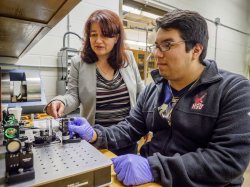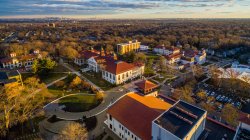Spotlight: News Briefs
Fast Start for Grants
For the first quarter of fiscal year 2019 — from July 1 through September 30, 2018 — Montclair State researchers have received $5.3 million in externally sponsored grants and contracts.
“Montclair State’s steady increase in extramural funding is a true testament to both the growth of our research enterprise as well as the strength of our research faculty,” says Vice Provost for Research and Graduate School Dean Scott Herness.
“The breadth of our funding portfolio — from educational assessment to astrophysics — is exactly what one would expect at a nationally designated doctoral research university,” Herness says.
“Our continued increase in funding from such competitive federal agencies, as the National Science Foundation and the National Institutes of Health, illustrates the high quality of the work done by our researchers and their doctoral students,” he says.
In fiscal year 2018, Montclair State received 84 grants totaling nearly $18 million from a diverse group of federal, state, local, private and international sources.
Finding the Most Distant Black Holes
Rodica Martin, a professor in the newly launched Department of Physics and Astronomy, is a member of the celebrated international LIGO — Laser Interferometer Gravitational-Wave Observatory — team that confirmed Einstein’s theory of relativity by detecting black hole collisions and neutron star mergers.
She has recently received a $90,000 National Science Foundation grant to study the optical properties of materials that can be used to develop the next generation of gravitational-wave detectors.

Martin’s research will focus on exploring new magneto-optical materials for the detectors’ Faraday isolators. “This grant will allow me to deepen my studies in new areas that contribute to increasing the sensitivity of future detectors,” she says.
“With more sensitive instruments, LIGO can detect gravitational waves from sources that are much further away, or that are too weak to observe with current detectors, giving us new insights into the dynamics of the cosmos.”
High-Tech Way to Test Water
With help from a $192,212 National Science Foundation grant, Montclair State professors are purchasing a Dynamic Imaging Particle Analyzer (DIPA) that will help them image, count and characterize particles from pollutants to algal cells that can degrade water quality — and harm people and aquatic life.
“The DIPA will let us process samples much more efficiently,” says Meiyin Wu, biology professor and director of the University’s Passaic River Institute.
Wu, a project co-principal investigator with Earth and Environmental Sciences Professor Yang Deng, notes, “Currently, we process samples under a scope, which can take about three hours for a single sample. Now, it will only take about 10 minutes.
With its accurate, rapid analyses, the DIPA will be a core instrument for critical University research initiatives focusing on developing innovative water treatment technologies for the removal of water pollutants, as well as for identifying and characterizing freshwater algae.
Database Tracks Early Caribbean Census
History Professor Julia Landweber has received funding for a June 2019 residence at Brown University’s John Carter Brown Library for ongoing collaboration with Elizabeth Heath of Baruch College–CUNY to create a digital database focusing on the human populations — both free and enslaved — and agricultural production of early modern French Caribbean colonies.
By digitizing and linking census data to interactive digital maps, it will be possible for the first time to depict the development of multiple commodities across space and time in the early modern Caribbean.
“Our database will be a useful resource to both scholars and students, offering scholars an unprecedented opportunity to use GIS (Geographical Information Systems) tools to analyze demographic, economic and social trends in these colonies.”
